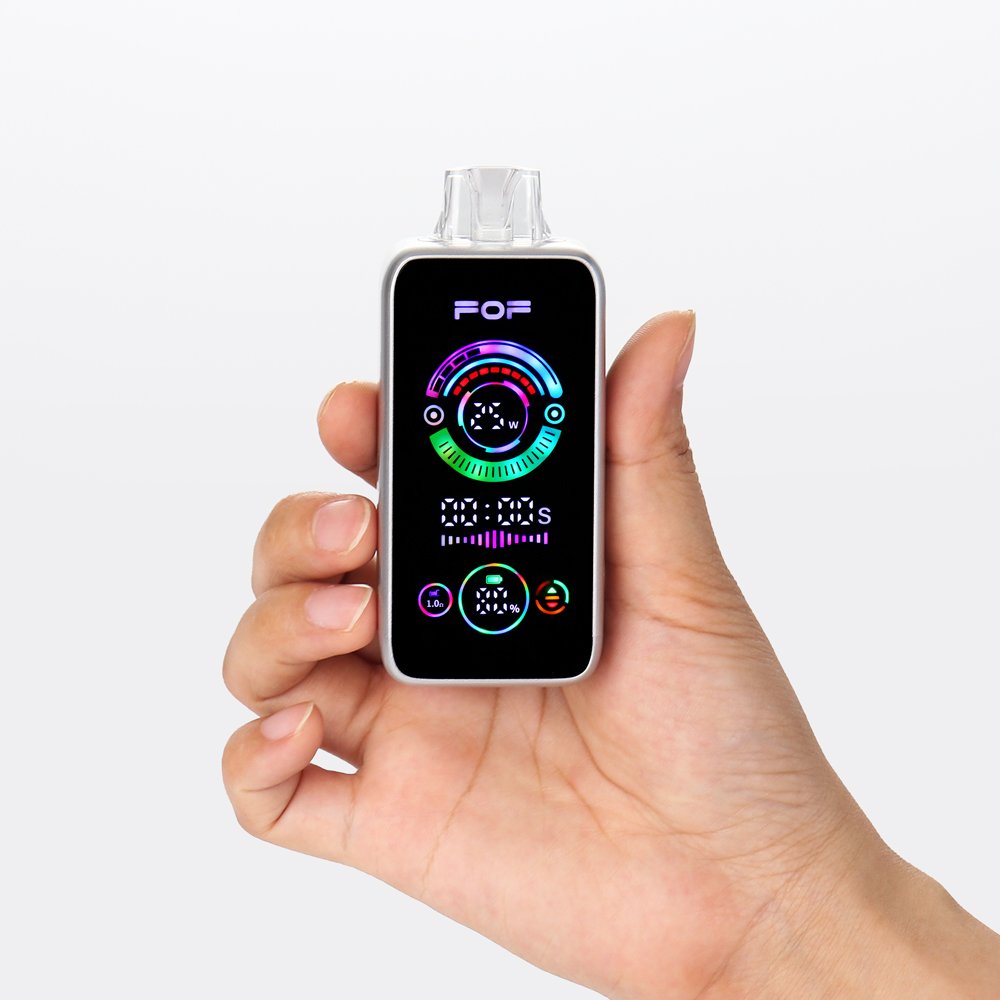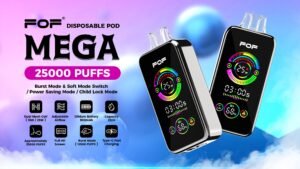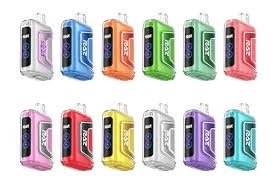Puffing away on what you thought was a safer alternative to smoking? You might be inhaling more than just flavored vapor. Many vapers remain unaware of the potentially harmful metals lurking in their devices, raising serious questions about long-term health effects.
Yes, scientific studies have found that e-cigarette aerosol (commonly called "vapor") can contain various toxic metals including lead, nickel, chromium, manganese, and arsenic. These metals primarily come from heating coils, soldered joints, and other components that release particles when heated. Concentrations vary widely between devices, with higher levels typically found in older, cheaper, or poorly maintained products.
 "E-cigarette components containing metals"
"E-cigarette components containing metals"
When I first discovered this research, I was concerned about what these metals might mean for the millions who've switched to vaping. The presence of these substances raises important questions about the comparative safety of e-cigarettes versus traditional smoking and how we might minimize potential risks.
Does vaping contain lead?
Parents and health professionals increasingly worry about lead exposure from vaping, especially among younger users. With lead's well-documented neurotoxicity and the rising popularity of e-cigarettes among teenagers, this question has taken on new urgency in public health discussions.
Yes, scientific studies have detected lead in e-cigarette aerosol, though concentrations vary significantly between devices. Research from Johns Hopkins University found lead in the aerosol of 94% of tested devices, with levels ranging from negligible to potentially concerning. The lead primarily originates from soldered joints, brass/brass-clad components, and lower-quality heating coils that release particles when repeatedly heated during vaping.
 "Scientific testing for lead in e-cigarette aerosol"
"Scientific testing for lead in e-cigarette aerosol"
Lead exposure remains one of the most concerning aspects of vape metal contamination due to its well-established toxicity and the absence of any safe exposure threshold, particularly for developing brains. Understanding where this lead comes from gives us insight into both the scale of the problem and potential solutions.
The presence of lead in e-cigarette aerosol1 has been documented through multiple independent laboratory analyses using sophisticated detection methods. Through careful examination of the available research literature, I've found that lead contamination displays several distinct patterns that help us understand its sources and variability. Device construction plays a crucial role in determining lead levels – analysis of component materials shows that older devices with more soldered joints typically release significantly higher lead concentrations, sometimes 2-5 times greater than newer models with fewer soldered connections. The manufacturing quality creates substantial variation – budget devices manufactured with less rigorous quality control typically show lead levels 3-8 times higher than premium products from manufacturers with stricter materials standards and production processes. Temperature settings demonstrate a clear correlation with lead release – laboratory testing reveals that devices operated at higher temperatures (typically above 200°C) release significantly more lead particles, with some studies documenting up to a 40% increase in lead concentration when comparing the same device operated at minimum versus maximum power settings. Usage patterns affect cumulative exposure – devices used more intensively (more frequent and longer puffs) show accelerated deterioration of components, with lead levels in the aerosol increasing by approximately 20-30% after extended use periods compared to new identical models. The coil material composition significantly impacts lead presence – stainless steel coils generally release less lead than Kanthal (iron-chromium-aluminum) or Nichrome (nickel-chromium) alternatives, though this advantage can be negated by other lead-containing components elsewhere in the device. Tank system design influences metal leaching – open tank systems with more metallic components exposed to e-liquid generally show higher lead transfer to the aerosol than closed pod systems, though exceptions exist based on specific materials used in each design. The e-liquid composition itself can affect lead extraction – higher acidity liquids (typically fruit flavors with citric acid) demonstrate enhanced ability to leach lead from components, sometimes increasing lead concentrations by 15-25% compared to more neutral e-liquid formulations in otherwise identical conditions.
The toxicological significance of the detected lead levels requires contextualizing against established health guidelines and comparing them to other exposure sources. Through careful analysis of public health standards and toxicology research, I can provide important perspective on these findings. The reference standards for lead exposure2 have evolved significantly over time – while the WHO currently suggests a blood lead level concern threshold of 5 μg/dL for adults, toxicologists increasingly recognize that no level of lead exposure can be considered truly "safe," with detectable health effects documented at even lower concentrations. Comparative exposure analysis places vaping-related lead in context – depending on the specific device and usage patterns, daily lead exposure from heavy vaping with certain devices can potentially approach or even exceed daily exposure from other regulated sources like water (EPA limit: 15 ppb) or food (FDA monitoring various thresholds). The bioavailability of inhaled lead particles presents specific concerns – pulmonary absorption of lead particles can reach 95% efficiency compared to approximately 15% for ingested lead, making even relatively lower concentrations in aerosol potentially more significant than higher concentrations in food or water. The particle size analysis raises additional concerns – research using cascade impactors and electron microscopy reveals that lead in e-cigarette aerosol often exists as ultrafine particles (diameter <100 nm) that can penetrate deeper into lung tissue and potentially enter circulation more readily than larger particles. Blood lead level studies in regular vapers show mixed results – some studies document modest but statistically significant elevations (typically 0.5-2.0 μg/dL increases) in blood lead among regular vapers compared to non-smokers, while other studies show no significant difference, suggesting that device selection and usage patterns likely create highly variable exposure scenarios. The elimination half-life of lead in the body (approximately 30 days in blood, but up to decades in bone) creates potential for bioaccumulation with regular exposure, even at relatively low concentrations, particularly concerning for long-term daily users. The established health effects of chronic low-level lead exposure include subtle neurocognitive impacts, cardiovascular effects, decreased kidney function, and reproductive system effects, though the precise threshold at which these manifest varies significantly between individuals based on genetics, nutritional status, and concurrent exposures. The particular vulnerability of specific populations – especially adolescents whose brains are still developing, pregnant women due to placental transfer of lead to fetuses, and individuals with existing kidney dysfunction – creates heightened concern for these groups even with relatively modest exposure levels.
The regulatory landscape3 surrounding lead in e-cigarettes remains inconsistent globally, creating challenges for consumer protection and industry standardization. Through analysis of regulatory approaches across multiple jurisdictions, I've identified significant gaps and inconsistencies in how this issue is addressed. The FDA's regulatory framework for e-cigarettes in the United States does not currently include specific limits for lead or other metals in e-cigarette aerosol, though the agency has expressed concern about the issue and continues to evaluate potential regulatory approaches. The European Union's Tobacco Products Directive (TPD) similarly lacks specific limits for metals in e-cigarette aerosol, focusing instead on liquid composition, nicotine concentration, and device safety features without directly addressing metal emissions. The testing methodologies for measuring metals in e-cigarette aerosol remain non-standardized – different research groups and regulatory bodies utilize varying collection methods, analytical techniques, and reporting standards, making direct comparisons between studies challenging and complicating regulatory enforcement. The disclosure requirements to consumers about potential metal content remain minimal or nonexistent in most markets – unlike cigarette packaging with standardized warnings, e-cigarette packaging rarely contains information about potential metal exposure, limiting consumers' ability to make informed choices. The industry self-regulation efforts show significant variability – some premium manufacturers implement voluntary testing and materials standards to minimize metal contamination, while others meet only minimum regulatory requirements, creating substantial quality disparities in the market. The product certification systems that could address metal contamination remain largely underdeveloped – unlike some other consumer product categories with independent certification for contaminant levels, e-cigarette certification systems remain limited in scope and adoption. The international standards organizations including the International Organization for Standardization (ISO) and CORESTA (Cooperation Centre for Scientific Research Relative to Tobacco) have developed some voluntary standards for e-cigarette testing, but specific metals testing protocols and acceptable limits remain works in progress rather than finalized standards. The scientific consensus statements from organizations like the National Academies of Sciences, Engineering and Medicine acknowledge the presence of metals in e-cigarette aerosol as a legitimate health concern requiring further research and potential regulatory action, though stopping short of making specific regulatory recommendations due to ongoing research gaps.
Practical considerations for reducing potential lead exposure from vaping involve both device selection and usage behaviors that consumers can control. Through analyzing available research and applying materials science principles, I've identified several evidence-based strategies for minimizing exposure risks. Device quality selection represents perhaps the most significant factor consumers can control – investing in products from established manufacturers with documented quality control procedures and materials testing typically reduces metal exposure, as confirmed by studies comparing budget versus premium devices using identical testing protocols. Regular maintenance practices demonstrably reduce metal release – replacing coils at recommended intervals (typically every 1-2 weeks for regular users) prevents the accelerated metal leaching documented in aging coils which can release up to 25-30% more metals as they deteriorate. Temperature control settings significantly impact metal release – operating devices at lower power settings within manufacturer recommendations reduces heating element temperatures, with studies documenting approximately 30-40% lower metal concentrations in aerosol produced at minimum versus maximum power settings of the same device. Pre-heating practices ("priming" new coils) before first use reduces initial metal release – laboratory testing shows that discarding the first few puffs from a new coil, which typically contain higher metal concentrations from manufacturing residues, can reduce initial exposure. Device material considerations offer potential advantages – systems using medical-grade stainless steel or ceramic components generally demonstrate lower lead and other metal release compared to those using brass, copper alloys, or lower-grade materials, though manufacturer claims should be verified through independent testing when possible. Component compatibility awareness prevents unintended contamination – using only manufacturer-recommended parts rather than aftermarket or cross-brand components ensures proper fitting and reduces stress on connections that can accelerate corrosion and metal release. Storage practices affect long-term contamination levels – storing e-liquids away from device components rather than allowing extended contact (as in pre-filled tanks left unused for days) reduces the leaching time for metals to migrate into the liquid. The awareness of risk indicators helps users identify potential problems – unusual tastes (particularly metallic flavors), discoloration of components, or visible corrosion should prompt immediate component replacement, as these often correlate with significantly increased metal release as confirmed in laboratory testing of visibly degraded versus new components.
What are 3 harmful chemicals found in vapes?
Many people switch to vaping believing it's completely safe, only to discover concerning reports about chemical hazards. This leaves them feeling misled and unsure about whether they've simply traded one health risk for another, creating anxiety about potential long-term damage.
Three harmful chemicals commonly found in e-cigarette vapor include: 1) Nickel – a known respiratory irritant and potential carcinogen that primarily comes from heating coils; 2) Formaldehyde – a carcinogenic compound that forms when e-liquids are overheated; and 3) Diacetyl – an artificial flavoring linked to serious lung disease ("popcorn lung") found in some flavored e-liquids. The presence and concentration of these chemicals vary significantly between products and how they are used.
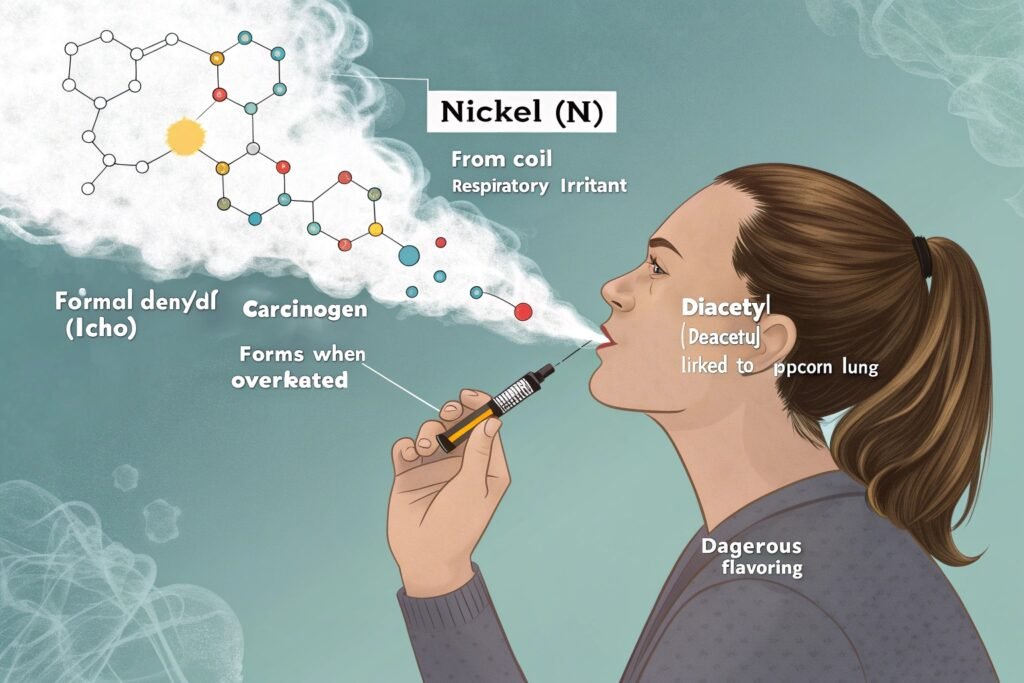 "Laboratory testing of harmful chemicals in vape aerosol"
"Laboratory testing of harmful chemicals in vape aerosol"
While public discussion often focuses on nicotine, these additional chemicals represent significant health concerns that deserve attention. Understanding their sources helps vapers make more informed choices about the products they use and how they use them.
Nickel in e-cigarette aerosol4 represents a significant concern due to both its prevalence and potential health effects. Through analyzing scientific studies employing inductively coupled plasma mass spectrometry (ICP-MS) and other advanced detection methods, I've found consistent documentation of nickel presence in vape emissions with several notable patterns. Source identification reveals that nickel primarily originates from heating coils – approximately 80-90% of e-cigarette devices use nickel-containing alloys (most commonly Nichrome or Kanthal) for their heating elements, which release nickel particles when heated repeatedly. Concentration variability across studies shows considerable range – from less than 1 ng/puff to over 20 ng/puff depending on device design, with higher concentrations typically associated with higher power settings and older coils. The bioavailability characteristics raise specific concerns – nickel released in e-cigarette aerosol often exists as ultrafine particles and soluble nickel compounds that demonstrate high absorption rates when inhaled, with animal studies suggesting respiratory absorption exceeding 90% for certain nickel compounds. The known health effects of nickel inhalation include respiratory irritation, decreased lung function, asthma exacerbation, immune system alterations, and in cases of long-term high-level exposure, increased risk of lung and nasal cancers, with the International Agency for Research on Cancer (IARC) classifying nickel compounds as Group 1 carcinogens (known human carcinogens). The exposure threshold comparison reveals concerns – regular vaping with certain devices can potentially exceed the California Office of Environmental Health Hazard Assessment (OEHHA) Reference Exposure Level for nickel inhalation, though typically remaining below Occupational Safety and Health Administration (OSHA) workplace exposure limits. The hypersensitivity implications create additional concerns – approximately 10-20% of the population has some degree of nickel sensitivity, with these individuals potentially experiencing enhanced adverse reactions to nickel-containing aerosol, including more severe respiratory symptoms and dermatological reactions if touching contaminated vapor residue. The biomarker studies tracking nickel exposure in vapers show mixed results – some studies document modest but measurable increases in urinary nickel concentrations among regular vapers compared to non-vapers, while other studies show no significant difference, likely reflecting the high variability in device emissions and individual usage patterns. The mitigation options for concerned users include switching to temperature-controlled devices that maintain coil temperatures below levels associated with maximum nickel release (typically keeping temperatures below 250°C), selecting devices with coils made from alternatives like pure titanium or stainless steel which generally release lower nickel concentrations, and regular coil replacement since nickel release typically increases as coils age.
Formaldehyde in e-cigarette aerosol5 represents a complex and somewhat controversial topic in vaping health research. Through careful examination of the analytical chemistry literature, I've found important nuances in how this compound appears in vape emissions. The formation mechanism differs fundamentally from metals – unlike nickel which is released directly from components, formaldehyde is primarily created through thermal decomposition of propylene glycol and glycerin (the main e-liquid bases) when they reach excessive temperatures, typically above 250-300°C. The concentration variability shows extreme ranges – studies document formaldehyde levels from nearly undetectable to potentially concerning levels exceeding tobacco cigarette emissions, with this dramatic range largely explained by differences in testing protocols rather than inherent to all products. The operating conditions create the most significant determinant of formaldehyde production – studies demonstrate that "dry puff" conditions (insufficient liquid reaching the coil) can increase formaldehyde production by 10-30 times compared to normal operating conditions with adequate liquid flow. The user experience correlation provides important context – the conditions that generate the highest formaldehyde levels typically produce harsh, acrid vapor that most users find unpleasant and would avoid, creating a potential sensory warning system against the worst exposure scenarios. The health significance stems from formaldehyde's classification as a Group 1 carcinogen by IARC, with known associations to nasopharyngeal cancer and leukemia through occupational exposure studies, though the intermittent exposure pattern from vaping differs significantly from the continuous occupational exposures that established these associations. The risk assessment challenges include accounting for formaldehyde's presence in the ambient environment – indoor air typically contains detectable formaldehyde from furniture, building materials, and other sources, complicating efforts to isolate the incremental risk from vaping compared to everyday exposure. The mitigation strategies for users concerned about formaldehyde include avoiding "dry puffs" by ensuring adequate liquid supply to coils, using temperature-controlled devices that prevent coils from reaching the thermal decomposition thresholds of PG/VG (keeping temperatures below 250°C), and avoiding extremely high power settings that can overheat e-liquid even with adequate supply. The comparative risk context remains important – while formaldehyde from vaping represents a legitimate concern warranting minimization, studies comparing emissions under realistic usage conditions typically show 85-95% lower formaldehyde levels from e-cigarettes compared to combustible cigarettes, providing important perspective for those using vaping as a smoking cessation method.
Diacetyl (2,3-butanedione) in e-cigarette products represents a concerning flavoring compound with established respiratory risks. Through reviewing both chemical analysis studies and medical literature, I've compiled evidence on this compound's presence in vaping products and its potential health implications. The prevalence patterns show significant improvement but ongoing concerns – early studies (2014-2016) detected diacetyl in approximately 70-80% of tested sweet-flavored e-liquids, while more recent testing shows reduced prevalence (20-30% of tested products) following increased awareness, though still remaining detectable in certain products, particularly in buttery, creamy, and certain fruit flavors. The concentration variability demonstrates wide ranges – detected levels in positive samples range from trace amounts to over 200 μg/ml in certain products, with older products generally containing higher concentrations than newer formulations. The historical context provides important background – diacetyl gained notoriety through its association with "popcorn lung" (bronchiolitis obliterans), a serious respiratory disease identified among microwave popcorn factory workers exposed to high airborne concentrations, leading to significant worker compensation cases and industry changes. The exposure pathway comparison creates important nuance – while the popcorn factory workers experiencing disease were exposed to much higher concentrations than typical vaping would produce, the direct inhalation route in vaping (versus ambient air exposure in factories) may partially offset this difference in concentration. The respiratory health mechanism involves diacetyl's irritant effects on bronchiolar epithelial cells, causing inflammation, scarring, and potentially irreversible narrowing of the small airways, though this progression from occasional exposure at vaping concentrations remains theoretical rather than documented in actual cases. The regulatory response has been significant but inconsistent – the European Union banned diacetyl as an e-liquid ingredient under the Tobacco Products Directive, while the United States has no specific prohibition, though many US manufacturers voluntarily removed it following increased awareness of potential risks. The diagnostic challenge for potential cases involves the non-specific nature of early symptoms – shortness of breath, dry cough, fatigue, and wheezing can have numerous causes, making attribution to specific vaping compounds difficult without detailed exposure history and specialized testing. The risk mitigation options for concerned users include selecting products specifically labeled "diacetyl-free" (though independent testing has occasionally found the compound even in some such products), avoiding flavor profiles most commonly associated with diacetyl (particularly buttery, creamy, custard, and certain brown flavors), and considering unflavored products which consistently test negative for the compound.
Are there vapes without toxic metals?
Many vapers feel trapped between their desire to avoid traditional cigarettes and growing concerns about metal exposure from e-cigarettes. This creates frustration, as finding truly "clean" vaping options seems increasingly difficult amid conflicting information and marketing claims.
While no e-cigarette can be guaranteed completely free of metal emissions, certain products minimize exposure through advanced design and materials. Devices using ceramic heating elements instead of metal coils, those with medical-grade stainless steel components rather than cheaper alloys, and pod systems with fewer metal parts generally show lower metal emissions in testing. However, even these improved designs still release some metal particles, albeit at significantly reduced levels.
 "Modern e-cigarette with ceramic heating element"
"Modern e-cigarette with ceramic heating element"
The quest for reduced-metal vaping options has driven innovation in the industry, with several technologies showing promise for minimizing exposure. Understanding these advancements helps consumers make more informed choices while recognizing that complete elimination remains technically challenging.
The advancement in reduced-metal vaping technologies6 represents an evolving response to growing consumer concerns about metal exposure. Through analyzing recent product innovations and independent testing data, I've identified several promising approaches with varying degrees of effectiveness. Ceramic heating element technology offers significant advantages – devices replacing traditional metal coils with ceramic heating elements demonstrate approximately 60-80% reduction in overall metal emissions based on comparative testing, with particularly notable reductions in nickel and chromium, though concerns about potential ceramic particle inhalation require further investigation. The medical-grade materials adoption shows measurable improvements – devices constructed with medical-grade stainless steel7 (316L grade) components release significantly fewer metal particles than those using standard commercial-grade metals or brass/copper components, with testing showing 40-60% reductions in total metal emissions when comparing otherwise similar designs. The reduced-solder construction techniques minimize lead exposure specifically – newer designs employing press-fit connections, threading, or other non-soldered assembly methods show consistently lower lead emissions, often below detection limits, compared to devices with multiple soldered joints that can release lead when heated. The temperature control sophistication creates indirect benefits – advanced devices with precise temperature limitation capabilities prevent the higher-temperature operation associated with increased metal release, with testing demonstrating approximately 25-35% lower metal concentrations in aerosol when comparing temperature-controlled versus unregulated operation of identical devices. The disposable component isolation represents a different approach – some systems isolate all heating elements and metal components in disposable sections that are replaced frequently, preventing the accumulation of corrosion and degradation byproducts that typically increase metal release in aging components. The coating technology applications show mixed results – some manufacturers apply ceramic, glass, or other non-metallic coatings to metal components to create barriers against direct e-liquid contact and subsequent metal leaching, though the durability of these coatings varies significantly between products and typically degrades over time. The zero-metal conceptual designs remain largely theoretical – true "metal-free" vaping systems using entirely glass, ceramic, and polymer construction have been proposed but face significant engineering challenges, particularly around creating durable electrical connections without metal components, keeping them largely in prototype rather than commercial stages.
The limitations of current testing and certification systems create significant challenges for consumers seeking reduced-metal vaping options. Through examination of current testing methodologies and market oversight, I've identified several critical gaps that complicate informed decision-making. The standardization deficiencies create fundamental problems – unlike well-established testing protocols for pharmaceuticals or food products, e-cigarette metal testing lacks universally accepted standards for sample collection, preparation, analytical methods, or reporting thresholds, making direct comparisons between products or studies challenging. The market surveillance limitations restrict transparency – most jurisdictions have minimal or no requirements for routine metal emissions testing of commercial products, meaning most devices reach consumers without any independent verification of metal release characteristics. The manufacturer testing variability introduces inconsistency – companies conducting internal testing may use widely different methodologies, reference standards, or sampling approaches, making manufacturer claims of "low metal" or "clean vapor" difficult to verify or compare between brands. The academic research limitations affect comprehensive understanding – most academic studies examining metal emissions test relatively small samples of available products (typically 5-20 models) rather than the hundreds of products available commercially, leaving significant knowledge gaps about the broader market. The detection threshold variations between studies complicate comparisons – different researchers employ various analytical instruments with different sensitivity levels and reporting thresholds, sometimes making "non-detection" in one study incomparable to "detection" in another using more sensitive equipment. The real-world usage simulation challenges affect applicability – laboratory testing typically involves standardized puffing regimens that may not accurately reflect the variable usage patterns of actual consumers, including differences in puff duration, frequency, and intensity that can significantly affect metal release. The certification program limitations leave verification gaps – unlike organic food or energy efficiency ratings, no widely recognized independent certification program exists specifically for low-metal or reduced-contaminant vaping products that consumers could use as reliable shopping guidance. The consumer testing accessibility remains extremely limited – while home testing kits exist for water contaminants and certain other environmental concerns, consumers have no practical way to test their own devices for metal emissions, leaving them dependent on manufacturer claims or academic research that may not apply to their specific products.
The practical approach to minimizing metal exposure while vaping requires a multifaceted strategy combining product selection and usage behaviors. Through analyzing available evidence and engineering principles, I've developed a framework for realistic harm reduction. The comprehensive device evaluation involves multiple criteria – selecting devices with minimal metal components exposed to e-liquid, avoiding products with brass or copper components in the liquid path, preferring medical-grade stainless steel2 or ceramic construction, and choosing products with fewer soldered connections all contribute to reduced metal exposure based on comparative testing. The maintenance optimization plays a crucial role – replacing atomizers/coils at or before manufacturer-recommended intervals prevents the increased metal release documented in aging components, regularly cleaning residue from connection points reduces corrosion that can accelerate metal release, and ensuring proper electrical connectivity prevents hot spots that increase localized heating and subsequent metal emission. The operating parameter awareness significantly impacts exposure – avoiding high-temperature settings that accelerate metal release, preventing "dry hits" that can superheat components, and allowing adequate cooling between puffs all demonstrably reduce metal concentrations in resulting vapor. The e-liquid selection factors indirectly affect metal exposure – choosing less acidic formulations (typically non-citrus flavors) reduces the liquid's ability to leach metals from components, using formulations with chelating agents can potentially bind some metal ions in solution reducing their transfer to aerosol, and selecting liquids with appropriate viscosity for the specific device ensures proper wicking and prevents localized overheating. The storage considerations preserve device integrity – storing devices and components in dry environments prevents corrosion that increases metal release, avoiding extreme temperature fluctuations that can stress materials and connections, and keeping e-liquid bottles away from metal components prevents extended leaching during storage. The manufacturer research goes beyond marketing claims – investigating company documentation of materials testing, seeking evidence of specific metals testing rather than generic "safety" claims, and prioritizing manufacturers who specifically address metal emissions in their quality control processes typically correlates with lower-emission products. The realistic expectations remain essential – understanding that current technology cannot completely eliminate metal exposure during vaping, recognizing that even reduced-metal devices will release some particles, and considering personal risk tolerance when deciding whether any level of metal exposure is acceptable for individual circumstances provides necessary perspective for informed decisions.
What precious metals are in vapes?
When disposing of old devices, many vapers wonder if their e-cigarettes contain valuable metals. This curiosity stems from growing awareness about electronic waste recycling and potential recovery value, leaving users unsure whether their used vapes deserve special disposal consideration.
While e-cigarettes don't typically contain precious metals like gold or silver in recoverable quantities, they do contain small amounts of valuable metals including copper in wiring and circuit boards, lithium in batteries, and sometimes platinum group metals in higher-end temperature sensors. The concentration of these metals is generally too low for individual recovery, but specialized e-waste recycling facilities can process large quantities of devices to extract these materials economically.
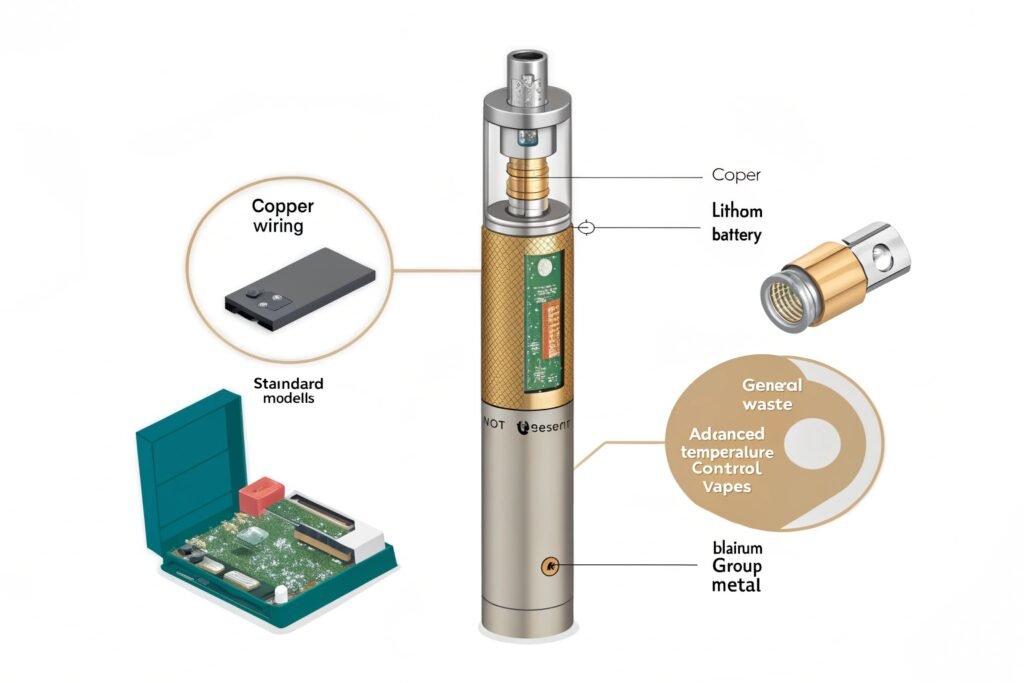 "Disassembled e-cigarette showing internal components"
"Disassembled e-cigarette showing internal components"
The materials composition of e-cigarettes reflects their position as miniaturized electronic devices, incorporating various metals for their electrical, thermal, and structural properties. Understanding this composition provides insight into both the resources embedded in these products and their proper end-of-life management.
The material composition analysis of modern e-cigarette devices reveals a complex assembly of metals serving various functional roles, some with significant economic value. Through systematic disassembly studies and materials characterization research, I've compiled data on the typical metal content of these products. The battery composition represents significant value – rechargeable lithium-ion batteries1 in modern devices typically contain cobalt, lithium, nickel, and manganese in the cathode materials, with cobalt being particularly valuable (current market value ~$50,000/ton) though present in relatively small quantities per device (approximately 0.5-3 grams depending on battery capacity). The circuitry materials include trace precious metals – advanced device circuit boards contain minute quantities of gold in connector plating (typically nanograms to micrograms), silver in certain solder formulations, and copper in wiring and traces, though in substantially smaller quantities than found in larger electronics like smartphones or computers. The sensor components in premium devices – particularly those with advanced temperature control features – sometimes incorporate platinum, palladium, or ruthenium in temperature sensors and precision resistors, though in extremely small quantities (typically <0.001 grams per device). The structural metals comprise the largest portion by weight – stainless steel, aluminum, and zinc alloys predominate in device housing and structural components, with these materials having modest but stable recycling value in sufficient quantities. The heating element composition varies significantly – while most contain nichrome (nickel-chromium alloy) or kanthal (iron-chromium-aluminum alloy) with moderate recycling value, some premium temperature control devices use small amounts of titanium or stainless steel for coils, which have higher value in recycling streams. The connection components often contain materials of concern – brass (copper-zinc alloy) components are common in connection points, sometimes with nickel or gold plating in premium devices to prevent corrosion and ensure consistent electrical connectivity. The specialized component trends in newer devices – some advanced models incorporate specialized materials like molybdenum in heating elements for temperature stability, tungsten in high-durability components, or tin in certain connection technologies, each with varying recovery value in recycling processes. The recovery economics remain challenging for individual devices – while the combined metal value per device ranges from approximately $0.20 for basic models to $2-3 for advanced devices with larger batteries, this value only becomes economically recoverable when processing thousands of units through specialized e-waste recycling2 facilities.
The environmental and sustainability implications of metals in e-cigarettes extend beyond simple economic recovery value to broader resource management concerns. Through analyzing life cycle assessment data and waste stream impacts, I've identified several critical considerations regarding the environmental footprint of these products. The resource intensity of production is substantial – manufacturing a typical rechargeable e-cigarette device requires extraction and processing of over a dozen different metals, consuming approximately 1-2 kg of raw ore materials to produce a device weighing 30-100 grams, representing significant resource concentration. The disposal pathway reality creates concerning patterns – surveys indicate approximately 80-90% of e-cigarette devices enter regular municipal waste streams rather than specialized e-waste recycling, potentially releasing metals into landfill environments where battery components particularly pose leaching risks. The recycling infrastructure limitations complicate proper handling – most municipal recycling programs lack specific provisions for e-cigarette collection and processing, with their small size and mixed material composition creating challenges even within established e-waste recycling systems designed primarily for larger electronics. The landfill leachate concerns arise from improper disposal – battery components containing cobalt, nickel, and lithium can potentially contaminate leachate when casings eventually degrade, with one environmental modeling study suggesting a single lithium-ion battery can contaminate approximately 1,000 liters of landfill leachate with metal concentrations exceeding safe drinking water standards. The fire risk during waste management presents acute hazards – lithium-ion batteries in e-cigarettes have caused numerous documented fires in waste collection vehicles and processing facilities when damaged during compaction or shredding, creating both environmental releases and worker safety hazards. The design for recyclability remains largely absent – unlike some larger consumer electronics incorporating design features to facilitate end-of-life disassembly and material separation, most e-cigarettes use permanent assembly methods like gluing and welding that complicate component separation for efficient recycling. The producer responsibility programs3 show significant geographic variation – while the European Union's WEEE (Waste Electrical and Electronic Equipment) Directive theoretically covers e-cigarettes as electronic devices requiring producer-funded collection and recycling, practical implementation remains inconsistent, and many other regions lack any comparable programs. The circular economy opportunities exist but remain largely unrealized – the concentrated valuable metals in these devices could theoretically support closed-loop recycling models where recovered materials reenter the production stream, but current low collection rates (estimated at 2-5% of devices in most markets) prevent meaningful implementation of such systems.
The practical guidance for responsible disposal of e-cigarette devices can help users minimize environmental impacts from these metal-containing products. Through reviewing best practices and available disposal infrastructure, I've developed actionable recommendations for different device types and locations. The battery removal and separation represents the highest priority – for devices with accessible batteries, removing and separating these components for dedicated battery recycling creates the greatest environmental benefit, as this isolates the most potentially hazardous and valuable components. The retailer take-back programs offer convenient options – an increasing number of vape shops and specialty retailers offer collection services for used devices and components, with approximately 15-20% of specialty retailers in urban markets now providing some form of collection service, though availability remains limited in rural areas. The manufacturer mail-back programs provide additional options – some larger manufacturers have established mail-back recycling programs for their products, allowing consumers to return used devices for proper processing, though these programs typically serve only 3-5% of discarded devices due to limited consumer awareness and participation barriers. The e-waste event utilization presents periodic opportunities – many communities host periodic household hazardous waste or electronics collection events that accept small electronic devices including e-cigarettes, typically providing the most environmentally sound processing options when available. The battery recycling locations serve critical functions – many home improvement stores, electronics retailers, and municipal facilities maintain collection points specifically for batteries, including the lithium-ion types used in e-cigarettes, providing specialized handling for these components even when complete device recycling options aren't available. The device disassembly considerations affect recycling potential – while complete disassembly generally exceeds consumer capabilities, simple separation of batteries, removable tanks, and outer casings can significantly improve recyclability when depositing in e-waste collection points. The hazard mitigation for damaged devices requires special attention – devices with damaged batteries or signs of leakage should be placed in sand, cat litter, or similar materials before being sealed in plastic bags and taken to hazardous waste collection points rather than regular e-waste streams, preventing fire risks during transportation and processing. The international variation in available infrastructure creates significant geographic disparities – consumers in the European Union generally have access to more comprehensive collection systems through WEEE implementation, while those in North America have more fragmented options requiring greater consumer initiative to locate appropriate disposal channels.
Conclusion
E-cigarette vapor does contain toxic metals including lead, nickel, and chromium, though levels vary significantly between devices. While no vaping product is entirely metal-free, certain designs minimize exposure through advanced materials and construction techniques. For health-conscious vapers, selecting quality devices, maintaining them properly, and understanding their composition represents the best approach to reducing potential risks.
-
Exploring the relationship between e-cigarette aerosol and metal contamination can help consumers understand potential health risks. ↩ ↩
-
Understanding the health risks of lead exposure in vaping is crucial for making informed choices about e-cigarette use. ↩ ↩ ↩
-
Learning about the regulatory landscape for lead in e-cigarettes can inform consumers about safety standards and protections. ↩ ↩
-
Understanding the health implications of nickel exposure in vaping can help users make informed choices about their products. ↩
-
Exploring the risks of formaldehyde can provide insights into safer vaping practices and potential health impacts. ↩
-
Explore this link to understand the innovative technologies that minimize metal exposure in vaping, ensuring safer choices for consumers. ↩
-
Learn about the advantages of medical-grade stainless steel in vaping, which can lead to safer and cleaner vaping experiences. ↩

